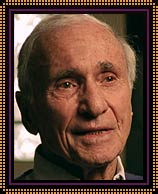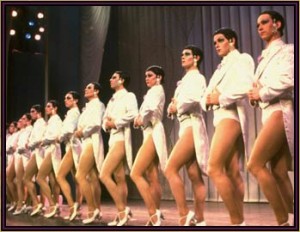 An American writer whose work dates back to radio and whose films and Broadway productions — many of which he has also directed — have included classic works such as “West Side Story” and “Gypsy” and such highly entertaining fare as THE WAY WE WERE and THE TURNING POINT. Arthur Laurents was barely 21 when he wrote his first radio play “Now Playing Tomorrow” in 1939. He went on to write episodes of “Dr. Christian,” “The Thin Man,” and numerous originals. During W.W. II, he wrote “Armed Service Forces Present” as well as “This Is Your FBI.”
An American writer whose work dates back to radio and whose films and Broadway productions — many of which he has also directed — have included classic works such as “West Side Story” and “Gypsy” and such highly entertaining fare as THE WAY WE WERE and THE TURNING POINT. Arthur Laurents was barely 21 when he wrote his first radio play “Now Playing Tomorrow” in 1939. He went on to write episodes of “Dr. Christian,” “The Thin Man,” and numerous originals. During W.W. II, he wrote “Armed Service Forces Present” as well as “This Is Your FBI.”
Laurents’ first play, “Home of the Brave,” was a hard-hitting look at the plight of a Jewish GI during the War and opened on Broadway in 1945 and in London (as “The Way Back”) in 1946. “The Bird Cage” followed in 1950, then “The Time of the Cuckoo” (1952) and “A Clearing in the Woods” (1957). In 1957 also came “West Side Story,” with music by Leonard Bernstein and lyrics by Stephen Sondheim. Originally conceived by Jerome Robbins (who directed and choreographed) as a twist on “Romeo and Juliet” using Jews and Catholics (and called “East Side Story”), it was transformed by Laurents and Bernstein into the tale of Polish-American Romeo and Puerto Rican Juliet, while their respective gangs fight a street war. Laurents followed this with the book for “Gypsy” (1959), based on the memoirs by Gypsy Rose Lee. The show reteamed Laurents, Robbins, and Sondheim (Jule Styne wrote the bouncy score) and gave Ethel Merman what was arguably her greatest stage triumph.
Arthur Laurents
- "Do I Hear A Waltz?"
- "Gypsy"
- "La Cage aux Folles"
- "West Side Story"
- Leonard Bernstein
- Harvey Fierstein
- Jerry Herman
- Angela Lansbury
- Ethel Merman
- Harold Prince
- Jerome Robbins
- Stephen Sondheim
- Barbra Streisand
- Jule Styne
Laurents began his directing career with his play “Invitation to a March” (1960), that featured incidental music by Sondheim. In 1962, Laurents directed (but did not write) the musical “I Can Get It for You Wholesale,” about the garment district. The cast included Lillian Roth, Elliot Gould, and a newcomer, Barbra Streisand, who played the secretary Yetta Marmelstein and nightly stopped the show with her one number. Laurents wrote the book for and directed the Sondheim musical “Anyone Can Whistle” (1964), which has developed a cult following. It also marked the musical theater debut of Lee Remick and Angela Lansbury. He turned his own play “The Time of the Cuckoo” into the musical “Do I Hear A Waltz?” (1965), which set Sondheim’s lyrics to Rodgers’ music. Although he was nominated for Tony Awards for “West Side Story” and “Gypsy,” Laurents did not win until “Hallelujah, Baby!” in 1967.
His ongoing work in the theater tapered off slightly in the ’70s while he concentrated on features. He directed Lansbury in the 1974 London premiere of “Gypsy” (and its subsequent Broadway incarnation the following year) and, in 1979, he directed and co-wrote Phyllis Newman’s one-woman show, “The Madwoman of Central Park West.” Laurents did not direct again until he helmed the musical version of “La Cage aux Folles” (1983), which, unlike the film on which it was based, expressed the outrage of the Albin character when his lover’s son tries to cast him aside. (This development may be a reflection of the influence of Laurents, book writer Harvey Fierstein and others involved in the production who are openly gay.) Laurents won a Tony Award for his direction of the musical. In 1989, Laurents again oversaw a revival of “Gypsy,” headed by Tyne Daly. Two years later, he wrote the book and directed the ill-advised stage musical “Nick and Nora,” inspired by the characters featured in “The Thin Man.”

The Cagelles from "La Cage aux Folles."
Laurents’ career in Hollywood as a screenwriter has almost been separate from his career in the theater, although he has sometimes been involved in the adaptation of his plays and musicals. His first screen credit was a shared one on THE SNAKE PIT (1948), a harrowing study of mental illness starring Olivia de Havilland. Laurents then adapted Patrick Hamilton’s play “Rope” (also 1948) for Alfred Hitchcock, which was loosely based on the Leopold-Loeb case. Other adaptations include ANNA LUCASTA (1949, with Philip Yordan), ANASTASIA (1956), based on the play about a woman who may or may not be the surviving daughter of the executed Russian Czar, and BONJOUR TRISTESSE (1958).
Laurents co-wrote most of the feature adaptations of his stage work, beginning with 1949’s HOME OF THE BRAVE, which altered his original story that centered on a Jewish soldier to that of a black soldier. With Ernest Lehman, he adapted WEST SIDE STORY (1961), with Natalie Wood and Richard Beymer, and with Leonard Spigelgass, he wrote GYPSY (1962), that featured a non-singing Rosalind Russell and Wood. He also worked on the screen version of “The Time of the Cuckoo” which became David Lean’s SUMMERTIME (1965). In 1973, Laurents adapted his own novel, “The Way We Were,” the story of the romance between a Jewish woman and a WASP gent broken apart by cultural and political differences. The result, starring Streisand and Robert Redford, was a throw-back to the classic “women’s pictures” and was a huge box-office success. Laurents followed with THE TURNING POINT (1977), which he also produced with its director Herbert Ross. Also a critical and commercial success, the film told the tale of two fortyish women, one an aging ballet star (Anne Bancroft), the other (Shirley MacLaine) who gave up dancing to raise a family and have a life of regrets.
Laurents has merely dabbled in TV. He wrote the 1967 NBC special THE LIGHT FANTASTIC; OR, HOW TO TELL YOUR PAST, PRESENT AND MAYBE FUTURE THROUGH SOCIAL DANCING, and he oversaw the adaptation of GYPSY (CBS, 1993) for Bette Midler.
Source: Excerpted from Baseline. BaselineStudioSystems — A Hollywood Media Corp. Company.
Photo credits: Photofest and Martha Swope

